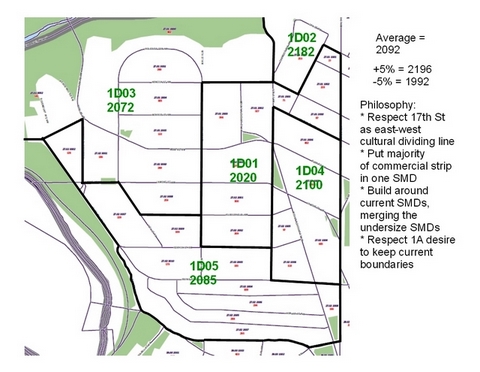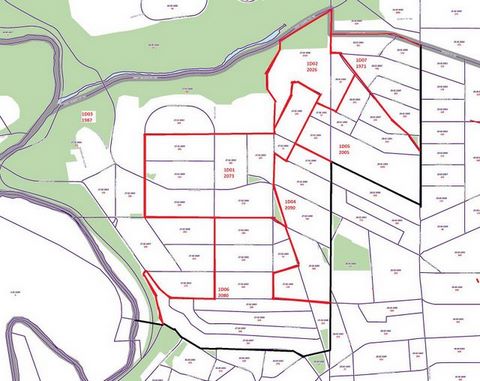I'm generally a pretty even-tempered guy, even when driving in DC traffic. I'm approaching 70, and getting mad about stuff is something I put behind me years ago. So it should have been surprising – “amazing”, one person wrote – that I would get into a sharp confrontation with Alan Roth, the chairman of the Ward One ANC Redistricting Task Force, at the public meeting of September 27. Here's one report on the incident http://briannekn.com/2011/09/28/ward-one-redistricting-task-force-community-discussion-2/ :
"The Chairman jumped back in and corrected Jack's point that ANCs have to be an integral multiple of 2,000 residents. What the law actually says is that SMDs should be approximately 2,000 +/-5% with a deviation that means they must be between 1900-2100 people, that they be as equal as possible, and there are exceptions allowed for public policy justifications. After this there was a request from Jack that he be permitted to clarify his statement, which was denied through some loud gaveling from the Chairman. As well as a threat from the Chairman that he would call the police if Jack didn't sit down. That moment was kind of like attending an ANC1B meeting during the Hunter regime."
Well, what was this about? I wasn't being angry about it; I was just insistent that I should be permitted to respond to Alan's unreasonable "correction" of my assertion that ANCs have to have populations that are integral multiples of 2000, or it becomes impossible to divide them into suitable SMDs (single-member districts). Alan tried to silence me, but I refused to be silent. I wasn't being angry; I was just unyielding, and insistent on responding to his absurd denunciation of my main point. I'm not easily intimidated by such two-bit "authority". And I believed I had the right to respond to his direct and explicit contradiction of what I had said. That's only fair.
Here's the point of dispute. The law indeed specifies that SMDs must have populations of "approximately 2000", and must be "as equal as possible". Well, ANCs are composed of some number N – an integer – of SMDs. Consequently the population of the ANC will be, approximately, 2000*N. If the populations of the SMDs must be 2000 ±5%, then the population of the ANC must be 2000*N, ±5%. Rocket science, this is not.

Well, what happens if the population of the ANC doesn't happen to be 2000*N, ±5%? Our ANC populations aren't regulated by anything, so there's nothing that says that those populations have to be suitable numbers. Consider Mount Pleasant, 1D, my home ANC. Its population, as of the 2010 census, is 10,459. Plainly we should divide it into 5 SMDs. But look out: its actual population is 4.59% above the 10,000 ideal. That's rather close to the 5% limit.
In fact, because this population number isn't very close to 10,000, it's quite impossible to divide 1D into 5 SMDs of population 2000, ±5%. The SMDs have to be made up of census blocks, and those come in hefty sizes, so you can't just make SMDs of whatever size you want. (Dividing up census blocks is possible, but strongly discouraged.) The best I've been able to do is illustrated here. That's five SMDs, “approximately 2000” in population, but two of them exceed the +5% limit, 2100. That's what happens when the population of the ANC isn't close to an integral multiple of 2000.
In short, my statement is correct: the population of an ANC must be (approximately) an integral multiple of 2000. If it isn't, then it becomes difficult or impossible to divide the ANC into SMDs with the legally required 2000, plus or minus 5%, populations. Why Alan cannot grasp, or refuses to grasp, that elementary point is beyond my understanding.This awkwardness of the ANC population has led to efforts to "fix" the 1D population by adding residents from neighboring ANCs. Alan Roth repaired the problem by adding 3773 residents from Columbia Heights, ANC 1A, to Mount Pleasant, creating a new ANC 1D with total population 14,232. That's seven SMDs, and the total population differs from the 14,000 ideal by just 1.6%. So this works, allowing the division of the enlarged ANC into seven SMDs. Alan essentially fixed the ANC population problem by adding residents to bring about a total that is close to an integral multiple of 2000.
Unfortunately, neither Mount Pleasant nor Columbia Heights is in favor of shifting that portion of 1A into 1D. I tried my own repair of the ANC1D population problem by adding a bit of Lanier Heights, 1712 residents, bringing the revised ANC1D population to 12,171. Plainly this corresponds to six SMDs, for which the integral multiple is 12,000. The "adjusted" population is just 1.4% different from that ideal, so again, division into 2000-population SMDs presents no great difficulties. Unfortunately, the residents of Lanier Heights are evidently not keen on becoming a part of the Mount Pleasant ANC. This is why this matter of ANC populations is so important in the current redistricting effort. If the ANC population isn't a convenient number, that is, an integral multiple of 2000, then it becomes difficult or impossible to create the legally required 2000-resident SMDs. But if the residents of adjacent ANCs object to being moved into another ANC, in order to get this population right, then we have an insoluble problem. That is in truth the central problem of ANC redistricting: how to create those legally required 2000-population SMDs, if the ANC populations aren't fortuitously convenient numbers, and the residents adjacent to that ANC don't want to be moved into it.
After I had spoken, Alan responded by denouncing my assertion that the populations of ANCs had to be multiples of 2000. As obvious as this may be, and as intimate is the connection to the legal requirement that the SMD populations be 2000, there's no written law that says that ANC populations have to meet this requirement. That requirement is implied by the law specifying 2000 for the population of SMDs, and the pretty obvious fact that ANCs must be composed of some integral number of SMDs. (Nobody's proposing fractional SMDs. Interesting concept, though.)
I figured that I must not have explained this very well, so I insisted on a moment to do a better job of making this understood. After all, having so directly challenged the truth of my statement, surely Alan owed me a chance to reply. But no; he refused to allow me that moment, demanding that I remain seated and silent.
I'm not so easily silenced, though, not when there's something important that must be understood. After all, this matter of difficult ANC populations is quite at the core of the problems in ANC redistricting. If these populations all happened to be nice multiples of 2000, there wouldn't be much involved in doing the SMD districting. The hard part comes when ANC boundaries have to be changed to make the numbers come out right. People don't like being moved from one ANC to another, especially when they had nothing to do with it.
So I refused to be silent. I continued with my explanation of this ANC population problem. Alan continued to try to silence me, demanding that I shut up and sit down. But I continued with my explanation, whereupon he began with the gavel, banging away on the desk, as if that would intimidate me, or maybe make so much noise that no one could hear me. Sorry, I'm not easily intimidated. I completed my explanation, finishing in Alan's face, advising him that yes, ANC populations had to be close to multiples of 2000, this being "just arithmetic". I wasn't being angry. Just assertive, in speaking the truth to this two-bit authority figure.
Then he said he would call the police if I continued to "disrupt" his meeting. "Go right ahead," I laughed. I meant that, too. It would have been quite something for this two-bit task force chair to have the police called to remove an ANC commissioner from a public meeting. Wouldn't the City Paper love that!
So, that's what happened at that meeting. There are times when people have to push back and assert
their rights, against the supposed authority of the likes of Alan Roth. Again, I'm a pretty even-tempered guy, and moments like that
have been very rare during my 9 years as an ANC commissioner. I just don't respond well to attempted intimidation. Alan Roth refused to
allow me even a minute to better explain my point. Had he given me that minute, he would have shown himself to be a gracious chairperson
of this meeting. But no, he wasn't going to be gracious, wasn't going to be even a tiny bit flexible. I was to shut up and sit down, without
being given any chance to defend myself against his charge that my statement, that ANC populations must be close to integral
multiples of 2000, was wrong.
Shame on Alan Roth. I'm pleased. I have an obligation to do all I can to compel this redistricting task force to do the job correctly.
We're going to have to live with its results for ten years to come, so this is important. I have a responsibility to do all I can
to get a reasonable result for Ward One. The first requirement is that the task force really understand the problem, beginning with
this matter of ANC populations.
So far, it's not evident that they do. It's an analytic job, requiring a bit of skill with numbers. Alan Roth evidently lacks the necessary
numerical and analytic skills, whereas I am pretty strong in this respect. (Being an engineer and scientist is a useful background for
solving this ANC/SMD redistricting problem.) Worse, he won't listen to anyone who does have skill with numbers. This Ward One redistricting
exercise is well on its way to being a disaster, due to incompetent leadership.
return to home page